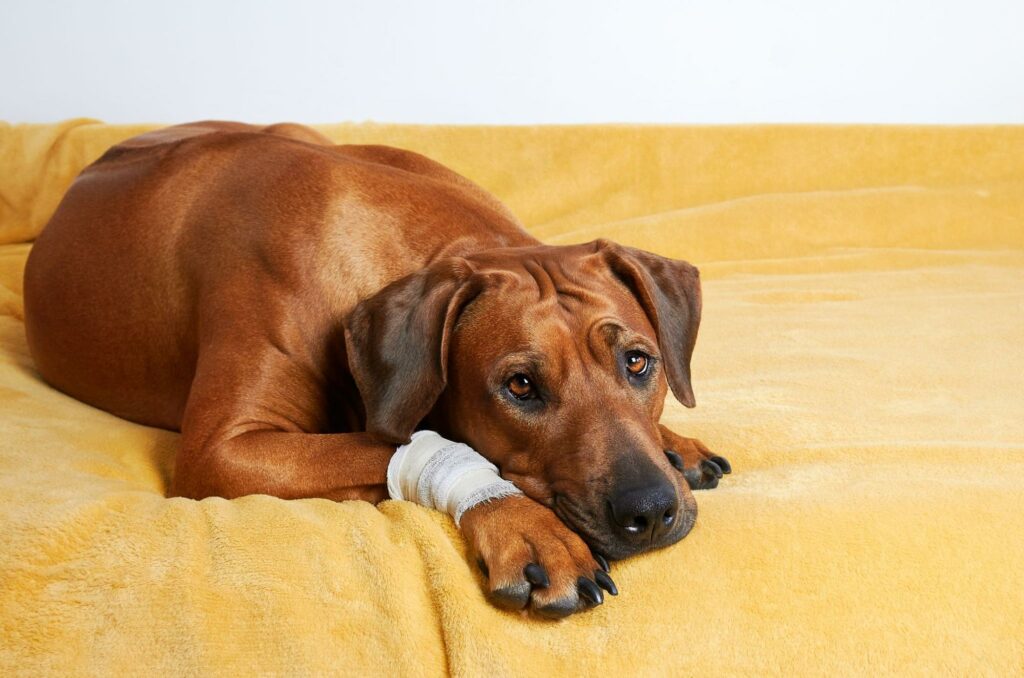When the top layers of skin are abraded, and tissue under the skin is not disturbed, we refer to this injury as a skin abrasion. Most superficial scrapes or wounds no longer than an inch or two can be treated with first aid, and larger or deeper abrasions require professional medical attention.

Types of Abrasions
Injuries can affect each dog differently. Knowing the difference of each type will aid you in understanding how to care for your pup and the type of first aid you or possibly your veterinarian will need to administer.
Bites and Punctures
A puncture can happen from stepping on a nail, stick, or any other sharp object, and bites can result from fighting with other animals. This injury can typically occur if your dog has the freedom to run around in a large area or if you are prone to take walks in the woods. If the injury is not adequately taken care of and cleaned, bacteria can get trapped in the wound and become infected, causing an abscess.
Insect Bites and Stings
When your pet is stung or bit by a bee, flea, spider, or tick, it can sometimes cause a reaction. These responses can be severe or just a nuisance. Vomiting, difficulty breathing, inflamed skin, and death are some of the more severe reactions to a bite or sting.
Torn Nails
A torn nail is a minor injury compared to others on this list, and however, it can cause bleeding and can be painful. The nail can pull by getting caught on a log or rock or if your pup jerks its paw quickly during a trimming session.
Lacerations & Abrasions
These cuts typically will heal all independently or with a bit of first aid administration. Depending on how deep the laceration is, surgery could be needed to repair the cut appropriately. If the object that caused the injury is dirty, then infection could set in, making even a tiny abrasion a severe risk for your pup.
How to Treat Minor Injuries
Be sure your hands are clean. Then gently clip the fur away from the wound. Fur in a healing wound can lead to contamination and delayed healing. Use warm water to flush the wound to remove dirt and debris from the area. Apply an antibiotic cream to the area three times daily. Distract the pet for a few minutes to keep your pet from licking off the medication. If the wound spreads or produces pus or the pet is uncomfortable, seek veterinary attention immediately.

Essential First Aid Items to Keep on Hand
Every pet owner should have an emergency first aid kit in their home and even in the car. Being prepared for a situation could mean life and death for your beloved family dog. You can rest easy and remain calm with a kit fully stocked and ready for use, even if you don’t think you will ever need it. Any bag, bin, container, or backpack is all you need for the essentials below. This list is not exhaustive, more items you may include can be found here.
Hydrogen Peroxide
Clean out wounds and cuts with hydrogen peroxide, and you can also use this solution for inducing vomiting if your furry friend has ingested something harmful. You should speak to your vet before administering for vomiting and do not perform without the guidance of a veterinarian.
Antibiotic Ointment
You will want to keep this in your car and your home for those times your pup gets a scrape or scratch. The ointment provides a barrier to keep out germs and dirt, which will help prevent infection. The antibiotic ointment also provides pain relief.
Scissors, Gauze, Tape, Rubber Gloves
Gauze is perfect to have on hand to stop bleeding and can even be fashioned as a makeshift muzzle. The tape holds the gauze in place, and scissors can cut an old t-shirt if you run out of gauze. Rubber gloves are essential in any emergency to protect yourself.
Wet Wipes
These might not seem like emergency items you need to have on hand. However, wet wipes come in handy to clean dirt or blood off a wound so you can have a better look. Wet wipes are perfect for cleaning bacteria and germs off your pup and other surfaces to prevent infection.
Blanket or Towel
If your pup is injured, a blanket wrapped around it can help calm and allow you to look at their wound and assess what type of care is needed. If you’re in a rocky area or the ground is too hot or cold, a towel provides a safe spot for your four-legged friend to lay on, and you can examine their abrasion.
Water, Treats, Food
These supplies might seem like apparent items to have on hand, but sometimes the most obvious ones are forgotten the most. Keep a small stash of water, food, or treats in your first aid bin. These items will come in handy when you don’t have access or need them to help distract your dog in an emergency.
Flashlight
Aside from the obvious reasons why a flashlight is helpful to have in your kit, using a flashlight can help you find a pill you dropped or see better to get a splinter out of your pup’s paw. It’s a good idea to stash some backup batteries and if you can, purchase a solar-powered flashlight and keep it in a spot where the daylight can charge it.
Simple Steps to Administering First Aid
First aid is the initial treatment offered after an emergency or injury. Following a few simple steps can assist you with the process of initiating treatment and getting your dog the help it needs.
Keep Calm
Your voice should be low and reassuring that everything will be ok. Check out your surroundings to ensure no more threats that could harm your furry friend.
Keep Dog Warm
Put a blanket, towel, or anything you may have on your dog and keep its movement to a minimum, especially if there’s a broken bone. The only time you don’t want warmth is during a heat stroke.
Contact Your Vet
Depending on the injury, you may want to reach out to your veterinarian for their advice if your pup should come to the office or if you can treat at home. If you have decided to administer first aid, we recommend a follow-up appointment to ensure a full recovery. Again, this all depends on the nature of the injury.
Restrain Safely
Animals tend to become distracted or disoriented at the onset of an injury. Sometimes the stress can cause a dog to act aggressively, so you will want to protect yourself, others around, and your pet by restraining. You can restrain your dog with a muzzle or by wrapping them in a blanket.
Transport Carefully
You can place a small dog into a carrier for transportation and remove the top for easier access. You should never push a dog into the cage, as this can worsen the injury. A makeshift stretcher or a box for larger dogs could be utilized for safe transporting.










